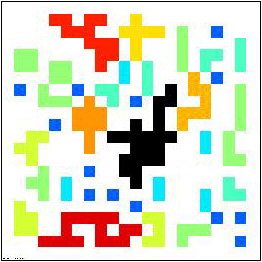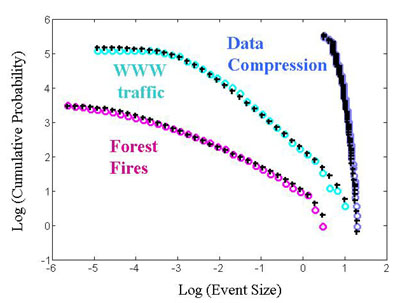 Percolation forest fire models are a familiar template for studying complexity and a starting point
for HOT. Percolation is the simplest model which exhibits a critical phase transition. Sites on a
two-dimensional square lattice are occupied (trees) or vacant (firebreaks). Contiguous sets of
nearest neighbor occupied sites define connected clusters. The forest fire model includes a coupling
to external disturbance, modeled by sparks which impact individual sites, burning through the
corresponding connected cluster. In the HOT version, the goal is to optimize yield, defined to be the
density remaining after a single spark. I have investigated a variety of different optimization
schemes, including optimal placement of vertical and horizontal strips of vacancies amidst an
otherwise full lattice, growth of an optimal forest by placing trees in the best location one at a
time, optimizing local densities in coarse grained regions of a superimposed design grid, and
Darwinian evolution by mutation and natural selection. All of these lead to similar results.
Optimized lattices consist of compact cellular regions of contiguous tress, separated by efficient
linear barriers formed by vacancies. These robustness barriers are concentrated in regions where
sparks are common, and sparse in regions where sparks are rare. Barriers to cascading failure is a
useful abstraction for robustness mechanisms in real systems. In some cases, barriers are physical
constraints (such as skin, cell walls, and highway lane dividers). However, barriers may also occur
in a system's state space, constructed via complex, regulatory feedback loops in the system's dynamics
(such as immune systems, and the TCP/IP protocol suite). The lattice models illustrate the emergence
of robustness barriers and other key features associated with HOT, including (1) high efficiency,
performance, and robustness to designed-for uncertainties, (2) hypersensitivity to design flaws and
unanticipated perturbations, (3) nongeneric, specialized, structured configurations, and (4) power
laws.
Percolation forest fire models are a familiar template for studying complexity and a starting point
for HOT. Percolation is the simplest model which exhibits a critical phase transition. Sites on a
two-dimensional square lattice are occupied (trees) or vacant (firebreaks). Contiguous sets of
nearest neighbor occupied sites define connected clusters. The forest fire model includes a coupling
to external disturbance, modeled by sparks which impact individual sites, burning through the
corresponding connected cluster. In the HOT version, the goal is to optimize yield, defined to be the
density remaining after a single spark. I have investigated a variety of different optimization
schemes, including optimal placement of vertical and horizontal strips of vacancies amidst an
otherwise full lattice, growth of an optimal forest by placing trees in the best location one at a
time, optimizing local densities in coarse grained regions of a superimposed design grid, and
Darwinian evolution by mutation and natural selection. All of these lead to similar results.
Optimized lattices consist of compact cellular regions of contiguous tress, separated by efficient
linear barriers formed by vacancies. These robustness barriers are concentrated in regions where
sparks are common, and sparse in regions where sparks are rare. Barriers to cascading failure is a
useful abstraction for robustness mechanisms in real systems. In some cases, barriers are physical
constraints (such as skin, cell walls, and highway lane dividers). However, barriers may also occur
in a system's state space, constructed via complex, regulatory feedback loops in the system's dynamics
(such as immune systems, and the TCP/IP protocol suite). The lattice models illustrate the emergence
of robustness barriers and other key features associated with HOT, including (1) high efficiency,
performance, and robustness to designed-for uncertainties, (2) hypersensitivity to design flaws and
unanticipated perturbations, (3) nongeneric, specialized, structured configurations, and (4) power
laws.
 Highly optimized Tolerance (HOT)
Highly optimized Tolerance (HOT) Percolation forest fire models are a familiar template for studying complexity and a starting point
for HOT. Percolation is the simplest model which exhibits a critical phase transition. Sites on a
two-dimensional square lattice are occupied (trees) or vacant (firebreaks). Contiguous sets of
nearest neighbor occupied sites define connected clusters. The forest fire model includes a coupling
to external disturbance, modeled by sparks which impact individual sites, burning through the
corresponding connected cluster. In the HOT version, the goal is to optimize yield, defined to be the
density remaining after a single spark. I have investigated a variety of different optimization
schemes, including optimal placement of vertical and horizontal strips of vacancies amidst an
otherwise full lattice, growth of an optimal forest by placing trees in the best location one at a
time, optimizing local densities in coarse grained regions of a superimposed design grid, and
Darwinian evolution by mutation and natural selection. All of these lead to similar results.
Optimized lattices consist of compact cellular regions of contiguous tress, separated by efficient
linear barriers formed by vacancies. These robustness barriers are concentrated in regions where
sparks are common, and sparse in regions where sparks are rare. Barriers to cascading failure is a
useful abstraction for robustness mechanisms in real systems. In some cases, barriers are physical
constraints (such as skin, cell walls, and highway lane dividers). However, barriers may also occur
in a system's state space, constructed via complex, regulatory feedback loops in the system's dynamics
(such as immune systems, and the TCP/IP protocol suite). The lattice models illustrate the emergence
of robustness barriers and other key features associated with HOT, including (1) high efficiency,
performance, and robustness to designed-for uncertainties, (2) hypersensitivity to design flaws and
unanticipated perturbations, (3) nongeneric, specialized, structured configurations, and (4) power
laws.
Percolation forest fire models are a familiar template for studying complexity and a starting point
for HOT. Percolation is the simplest model which exhibits a critical phase transition. Sites on a
two-dimensional square lattice are occupied (trees) or vacant (firebreaks). Contiguous sets of
nearest neighbor occupied sites define connected clusters. The forest fire model includes a coupling
to external disturbance, modeled by sparks which impact individual sites, burning through the
corresponding connected cluster. In the HOT version, the goal is to optimize yield, defined to be the
density remaining after a single spark. I have investigated a variety of different optimization
schemes, including optimal placement of vertical and horizontal strips of vacancies amidst an
otherwise full lattice, growth of an optimal forest by placing trees in the best location one at a
time, optimizing local densities in coarse grained regions of a superimposed design grid, and
Darwinian evolution by mutation and natural selection. All of these lead to similar results.
Optimized lattices consist of compact cellular regions of contiguous tress, separated by efficient
linear barriers formed by vacancies. These robustness barriers are concentrated in regions where
sparks are common, and sparse in regions where sparks are rare. Barriers to cascading failure is a
useful abstraction for robustness mechanisms in real systems. In some cases, barriers are physical
constraints (such as skin, cell walls, and highway lane dividers). However, barriers may also occur
in a system's state space, constructed via complex, regulatory feedback loops in the system's dynamics
(such as immune systems, and the TCP/IP protocol suite). The lattice models illustrate the emergence
of robustness barriers and other key features associated with HOT, including (1) high efficiency,
performance, and robustness to designed-for uncertainties, (2) hypersensitivity to design flaws and
unanticipated perturbations, (3) nongeneric, specialized, structured configurations, and (4) power
laws. An early, quantitative success of HOT was obtained by generalizing Shannon Coding from Information
Theory. This is the PLR model, defined by probabilities P, describing the relative likelihood of
a set of events, losses L, describing the associated cost, and resources R, which constrain the
loss. The PLR problem involves optimization of the allocation of limited resources to minimize the
expected loss over the spectrum of possible events. In the case of forest fires, the resources might
be firebreaks or other means of suppression. In the case of World Wide Web traffic, the analog of
sparks are hits by users browsing a site, and optimization arises in dividing documents into a limited
number of files in a manner which minimizes congestion of the server. The success of PLR theory lies
in the striking accuracy with which it describes statistical distributions for the size and frequency
of forest fires, World Wide Web downloads, and electric power outages.
An early, quantitative success of HOT was obtained by generalizing Shannon Coding from Information
Theory. This is the PLR model, defined by probabilities P, describing the relative likelihood of
a set of events, losses L, describing the associated cost, and resources R, which constrain the
loss. The PLR problem involves optimization of the allocation of limited resources to minimize the
expected loss over the spectrum of possible events. In the case of forest fires, the resources might
be firebreaks or other means of suppression. In the case of World Wide Web traffic, the analog of
sparks are hits by users browsing a site, and optimization arises in dividing documents into a limited
number of files in a manner which minimizes congestion of the server. The success of PLR theory lies
in the striking accuracy with which it describes statistical distributions for the size and frequency
of forest fires, World Wide Web downloads, and electric power outages.